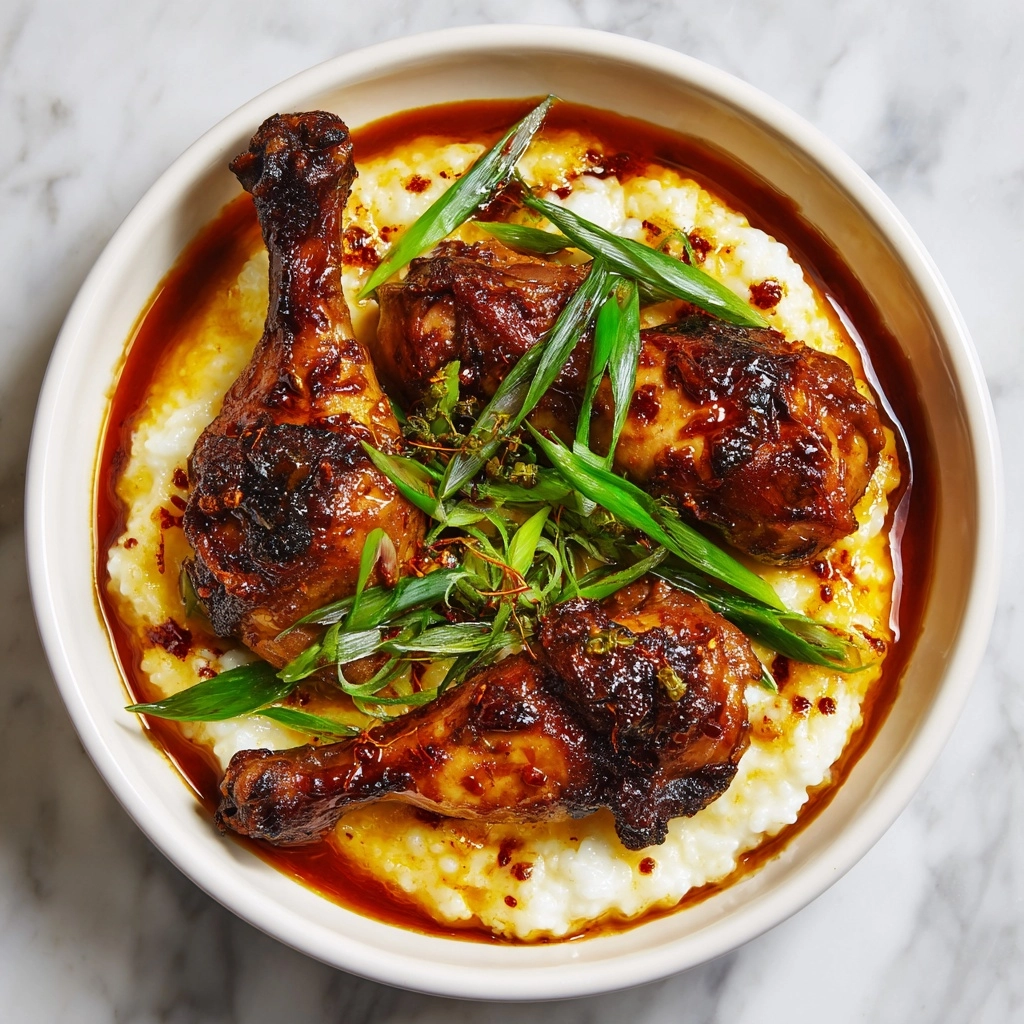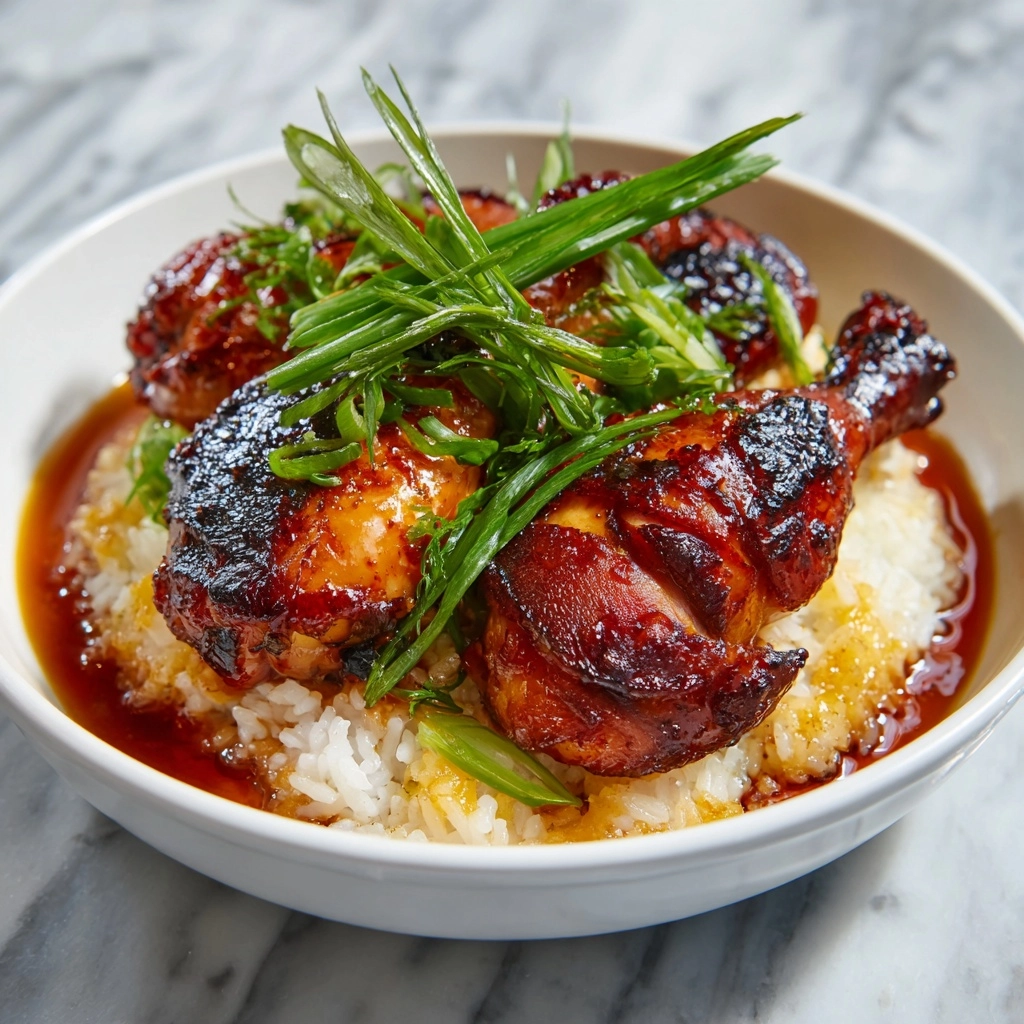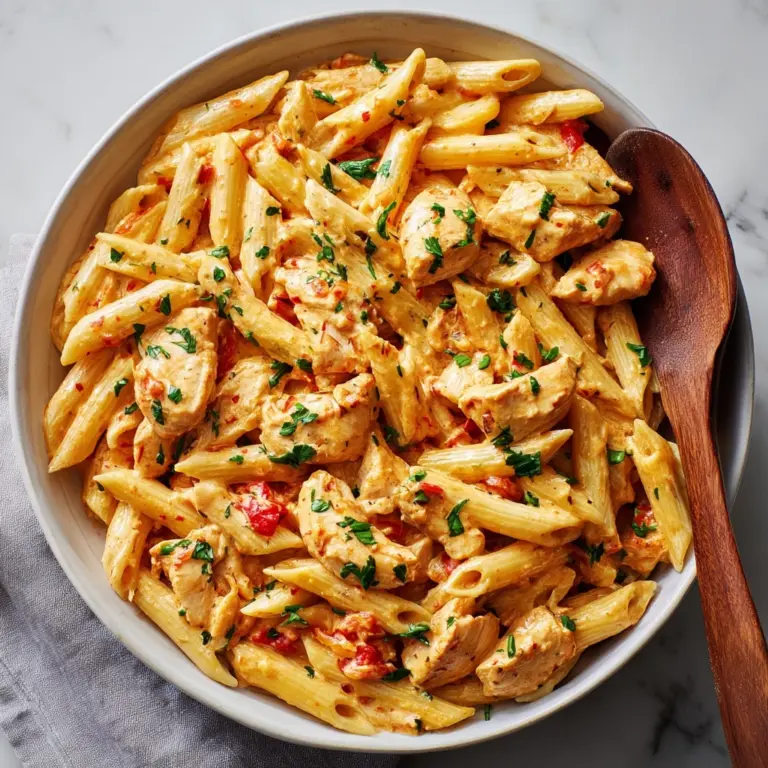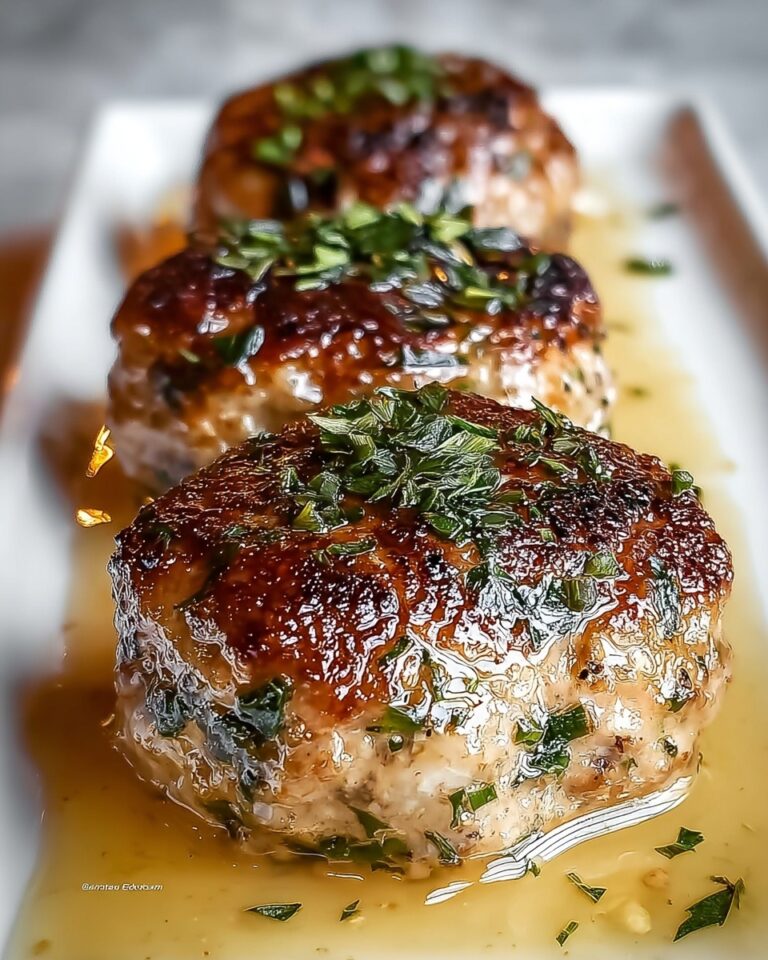If you’re craving comfort food with a dash of fire, look no further than Gochujang-Braised Chicken and Crispy Rice. This is the kind of weeknight dinner that warms your heart and electrifies your palate: juicy chicken thighs luxuriate in a sweet, spicy, garlicky bath of gochujang, while the rice gets its own golden moment with a satisfyingly crisp crust. It’s simple enough for a casual night in, yet bold and beautiful enough to impress your friends. Be warned—you’ll be thinking about that irresistible combo of saucy, tender chicken atop a crunchy bed of rice long after the last bite.

Ingredients You’ll Need
This recipe leans on a handful of pantry heroes and fresh staples, each playing a starring role in color, heat, and that craveable umami flavor. Don’t skimp on any of these vibrant contributors—they’re what set Gochujang-Braised Chicken and Crispy Rice apart!
- Boneless, skinless chicken thighs (1½ pounds): The best choice for maximum flavor and tenderness—thighs stay juicy during the braise.
- Gochujang (2 tablespoons): This spicy-sweet Korean chili paste is totally essential; it brings unmistakable depth and color.
- Soy sauce (1 tablespoon): Adds a salty, savory base to balance gochujang’s heat.
- Rice vinegar (1 tablespoon): Gives a little brightness that lightens up the rich sauce.
- Sesame oil (1 tablespoon): Infuses the chicken with warm, nutty aroma and flavor.
- Honey (1 tablespoon): A touch of sweetness rounds out the spice and adds shine.
- Garlic (2 cloves, minced): No explanation needed—garlic brings everything to life!
- Fresh ginger (1 teaspoon, grated): A little zing keeps the dish lively and fresh.
- Chicken broth (1 cup): Provides body for the sauce and helps tenderize the chicken.
- Jasmine rice (1 cup): Its fragrance and soft texture shine once transformed into a crispy-bottomed treat.
- Neutral oil (2 tablespoons, divided): Key for searing chicken and crisping the rice—use canola or vegetable oil for clean flavor.
- Green onions (2, thinly sliced): For freshness, crunch, and a pop of color right before serving.
- Toasted sesame seeds (1 teaspoon): Just a sprinkle adds a final nutty crackle.
- Kosher salt, to taste: For balancing all the flavors.
- Freshly ground black pepper, to taste: Lends a subtle kick of spice underneath the gochujang heat.
How to Make Gochujang-Braised Chicken and Crispy Rice
Step 1: Make the Marinade
In a bowl, whisk together gochujang, soy sauce, rice vinegar, sesame oil, honey, garlic, and ginger. This rich, glossy marinade packs punchy layers of flavor and aroma that soak straight into the chicken, making every bite absolutely irresistible.
Step 2: Marinate the Chicken
Season your chicken thighs with a good sprinkle of salt and black pepper, then toss them in the marinade. Whether you use a bowl or a zip-top bag, make sure each piece gets a generous coating. Let the flavors mingle for at least 30 minutes on the counter (or up to 4 hours in the fridge if you’ve got time to spare).
Step 3: Cook the Rice
While the chicken marinates, start your rice. Rinse jasmine rice until the water runs mostly clear, then simmer it with water and a pinch of salt until fluffy and tender. Let it rest and cool slightly, which gives the rice just the right texture for crisping later.
Step 4: Sear and Braise the Chicken
Heat half the oil in a large skillet or braiser over medium. Remove the chicken from the marinade, shaking off excess, and sear the pieces for 2 to 3 minutes per side—they should get a nice brown crust. Pour in the chicken broth along with any leftover marinade, cover, and braise over gentle heat for 20 minutes. You’ll be amazed at how tender the chicken becomes, while the sauce reduces to a shiny, luscious glaze.
Step 5: Crisp the Rice
Time for the crispy rice magic! In another large skillet set over medium-high heat, add the rest of the oil. Spread your cooked rice in a single, even layer. Using a spatula, gently press down on the rice and let it sizzle, undisturbed, for 5 to 7 minutes. The trick here is patience; resist stirring so the bottom develops a deep golden, ultra-crispy crust.
Step 6: Assemble and Serve
Once the rice crust is pronounced and the chicken is spoon-tender, it’s showtime. Heap generous scoops of the braised chicken and its luscious sauce over the crispy rice. Show it some love with a scattering of green onions and toasted sesame seeds. Serve hot and watch everyone swoon.
How to Serve Gochujang-Braised Chicken and Crispy Rice

Garnishes
A vibrant sprinkle of scallions and toasted sesame seeds is classic, but don’t hesitate to get creative—a few ribbons of pickled cucumber or a handful of thinly sliced red chili not only add a pop of color, but cut through the richness. Any fresh herbs you fancy (think cilantro or shiso) will also bring a dazzling, aromatic bite.
Side Dishes
Gochujang-Braised Chicken and Crispy Rice pairs beautifully with Korean banchan. Try serving alongside quick-pickled cucumbers, wilted spinach, kimchi, or simple sautéed greens. A crisp, crunchy salad tossed with a sesame or miso dressing balances the warmth and satisfies with every forkful.
Creative Ways to Present
If you’re feeling playful, serve Gochujang-Braised Chicken and Crispy Rice in individual bowls with the crispy rice at the bottom and a bright fan of toppings on top. You can also scoop servings into lettuce cups or roll with nori for a handheld, street-food twist. For a dinner party, arrange it as a gorgeous platter centerpiece, family-style.
Make Ahead and Storage
Storing Leftovers
If you’re lucky enough to have extras, store the cooled chicken and crispy rice separately in airtight containers. The flavors only deepen overnight, but to keep the rice crispy, refrigerate it uncovered for 30 minutes first before transferring to a container (this minimizes sogginess) and enjoy within three days.
Freezing
Gochujang-Braised Chicken and Crispy Rice components are both freezer-friendly! Store the braised chicken (with sauce) in a freezer-safe container for up to two months. The rice can be frozen too, but thaw it fully and re-crisp in a skillet before serving to restore its beloved crunch.
Reheating
To reheat, gently warm the chicken (and its sauce) in a saucepan over low heat, adding a splash of broth as needed. For the rice, use a hot skillet with a touch of oil to revive that crunchy texture—no microwave! This way, each element recaptures its just-cooked glory.
FAQs
Can I substitute chicken breasts for thighs?
You can, but chicken thighs stay much juicier and more tender during braising, while breasts might turn out a little dry. If you do use breasts, shorten the braising time slightly and check for doneness early.
What can I use instead of gochujang?
There’s really no substitute for classic gochujang’s sweet-heat and funky depth, but in a pinch, a mix of miso paste, chili paste, and a splash of honey gets you close. Just know the flavor profile will shift a bit.
How do I get the crispiest rice?
Make sure your cooked rice is dry and slightly cooled before pressing into the hot skillet. Don’t stir as it cooks—let patience (and heat) work their crispy magic. A nonstick or well-seasoned cast iron pan helps, too.
Is this dish very spicy?
Gochujang-Braised Chicken and Crispy Rice is flavorful and has a pleasant warmth, but it won’t overwhelm most palates. Up the heat with extra gochugaru, or keep it mellow by reducing the gochujang slightly.
Can I make this gluten-free?
Absolutely! Just be sure to use a gluten-free gochujang (many brands contain wheat) and swap in tamari for the soy sauce. Enjoy all the flavor, no gluten required.
Final Thoughts
If you’re ready to fall in love with dinner again, give Gochujang-Braised Chicken and Crispy Rice a try. It’s a dish that brings the thrill of texture, depth of flavor, and pure comfort to your table—one you’ll want to revisit again and again. Your taste buds (and your lucky guests) will thank you!







